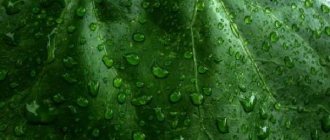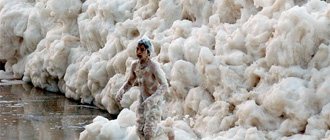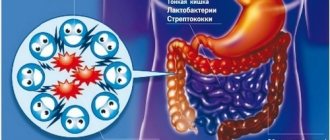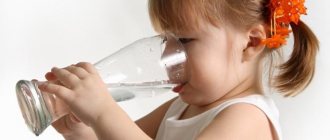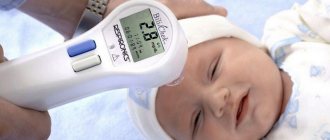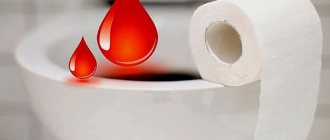What is diarrhea
With repeated excretion of stool in liquid form, doctors diagnose diarrhea. This is not an independent disease, but a symptom characteristic of pathologies of the intestines, stomach or pancreas. He indicates to the specialist that the person has had a disruption in the natural process of water absorption into the rectal mucosa, and destruction of the bonds between electrolytes.
In the absence of health problems, the child’s body excretes up to 100–150 grams of feces daily. The norm is approximate and depends on the diet, appetite and age of the baby. With diarrhea, nutrients do not have time to be absorbed into the epithelium, the flow of water into cells and tissues decreases: accelerated peristalsis removes them out, creating dangerous dehydration.
Liquid green stool is conventionally divided into two subspecies. Acute diarrhea lasts no more than 2 weeks and accompanies the infection. In the chronic form, greenish-colored feces are released in a volume of at least 300 grams per day, and the number of visits to the toilet reaches 6–8 times. In this case, a sign of a serious disorder is a large number of undigested pieces of food.
What should you be wary of?
Stool color isn't the only warning sign
Changes in stool may not always be caused by errors in diet: often green stool is a sign of illness. For children under one year old, dysbacteriosis becomes a common occurrence. This condition is caused by an imbalance of good and bad bacteria. What factors provoke the development of dysbiosis?
Often this condition is a consequence of early complementary feeding and the presence of juices in the baby’s diet. The second reason is previous infection. Everyone knows that taking antibiotics is a provoking factor responsible for the development of dysbiosis (it is not uncommon for dysbiosis to be diagnosed in the children of mothers who took antibiotics and were breastfeeding).
Often, when the first teeth appear, babies become capricious and try in every possible way to alleviate the discomfort that occurs in the oral cavity. Toys and hands carry bacteria into your mouth, causing green poop.
Read: How to properly collect stool for dysbiosis? Analysis transcript
With dysbacteriosis, the child experiences constipation, but more often foamy stools with an unpleasant odor are detected. The child suffers from colic. Mothers notice frequent regurgitation. An appropriate diagnosis is made using stool analysis.
Another option is the appearance of green stool caused by intestinal inflammation and the activity of intestinal bacteria. To prevent this process, you can advise mothers and relatives to stop licking the pacifier. Aggressive adult microbes can cause unpleasant conditions in the children's gastrointestinal tract.
Most infections are the result of the activity of pathogenic flora brought into the mouth with dirty objects. If your immune system is weakened, your own flora can also cause these problems. Microbes that were not previously thought to be dangerous can cause disturbances in the gastrointestinal tract.
Rarely are cases diagnosed when intestinal problems in children are provoked by pathogenic pathogens. Salmonella and E. coli can enter the baby’s body if adults ignore hygiene rules. Dysentery can be suspected when diarrhea and bloody stools appear. The thermometer records a high temperature, and the child suffers from abdominal pain.
You can get salmonellosis by eating raw or undercooked eggs. Domestic chickens also pose a danger, so egg dishes must be cooked.
Abundant and frequent loose stools quickly dehydrate the body, so the child should be monitored by a doctor.
Causes of green diarrhea in children
Green diarrhea in a child begins suddenly and may be accompanied by complaints of abdominal pain, vomiting and other unpleasant symptoms. In most cases, the cause is hidden in infection with different types of pathogens:
- pathogenic fungi (yeast);
- bacteria;
- enteroviruses.
Such species provoke the development of intestinal infections associated with the activity of staphylococci, streptococci, and Pseudomonas aeruginosa. Upon contact with the intestinal mucous membranes, their active reproduction begins. They not only change the acidic environment of the epithelium, but also provoke the death of beneficial microflora, which is unstable in infancy.
Dysbacteriosis
Green diarrhea in children of the first year of life often occurs due to intestinal dysbiosis. The disease is increasingly being diagnosed in bottle-fed babies. It is associated with an imbalance of microflora and a significant increase in colonies of pathogenic microorganisms. At this age, the causes of pathology and diarrhea are as follows:
- improperly selected nutrition;
- allergy to milk proteins;
- antibiotic treatment.
In this case, the child’s green, loose stool is replaced by prolonged constipation, problems with bowel movements, and painful spasms. The disease can only be determined by a special stool analysis for the level of bifidobacteria, lactobacilli, and their concentration in the rectum.
Staphylococcus aureus
The dangerous bacterium is very common in the environment.
It settles on the mucous membranes of the nose, genitals, and penetrates the intestines through the anus or esophagus. It is easy to infect a baby with daily care, during breastfeeding, or during the passage of the fetus through the birth canal. If a child has green diarrhea without fever, peeling or a rash on the skin of the abdomen, the pediatrician may refer you for stool tests. The bacterium gradually infects the child’s internal organs and parasitizes their membranes. It is difficult to destroy by boiling or freezing. But its presence in the body negatively affects well-being:
- the child has diarrhea with greens several times a day;
- immunity is greatly reduced;
- food is practically not digested;
- there is a lack of vitamins and minerals.
These factors create conditions for frequent colds and disrupt the harmonious growth and development of the child. Treatment of the disease is long-term and requires a careful approach and constant monitoring by an immunologist or gastroenterologist.
Introduction of new complementary foods
If a child has dark green diarrhea, the doctor asks the parents to list the diet and inquires about the baby’s daily menu. Often the cause of the painful condition lies in the parents’ violation of the rules of complementary feeding. This reaction of the body occurs to the following types of products:
- whole cow's milk;
- fatty meats or fish;
- Exotic fruits;
- nuts.
The problem is related to digestive disorders: many enzymes begin to be produced only after 3 years, the intestines cannot process new foods and fats. Liquid green stool in a child becomes a sign that the digestive system cannot cope with complementary foods; a reduction in portions or the selection of lighter ingredients is required.
In rare cases, dark green diarrhea in a child occurs due to liver pathologies, blockage of the hepatic ducts, or internal bleeding. When blood is excreted in the stool, it gives an atypical shade, black spots. Therefore, any changes in the baby’s stool or the appearance of white diarrhea is a reason to seek advice from a specialist.
Normal stool color in children
A greenish tint to light brown stool is normal for a breastfed baby. This color is provided by the pigment bilirubin, which, after some changes in the liver cells, is released in the form of stercobilin in feces and urobilin in urine.
When oxidized, a newborn's stool turns green, and this is also normal. The baby’s digestive system, including the liver, does not produce all the enzymes necessary to digest food. The intestines do not yet contain the required amount of beneficial microorganisms involved in the digestive process.
Even the liquid consistency of green stool is not a manifestation of the disease, but is due to the fact that the baby sucks only the so-called “front” breast milk, which is less fatty. But it is the fatty mother’s milk that gives the light brown color to baby’s stool.
Sometimes the baby is malnourished due to the mother’s flat or inverted nipples or insufficient active sucking on the tight breast. In these cases, the chair is established over a longer period of time.
Therefore, there is no need to worry if the child is calm, does not cry in pain, appetite and normal sleep are preserved, stools are not frequent, do not have mucus or a strong odor, and the newborn is gaining weight. While breastfeeding, the baby's stool color may change depending on the nature of the mother's diet.
Of course, a nursing mother must follow a diet. If a mother eats a lot of green vegetables or abuses carbohydrates, this can also cause the baby to have green stool. Spinach, parsley, broccoli, dill, green apples and pears, and cucumbers will cause greens in the stool.
In formula-fed babies, the green color of their stool may be due to the use of iron-rich formula. Mixtures such as NAN, Nutrilon and some others can give a green color. After consulting with your doctor, you can choose the appropriate formula for your child.
The beginning of the introduction of complementary foods, introducing children to the taste of apple, broccoli, pear, and too sweet porridge will also lead to a change in the color of the stool, which should not bother the mother if the baby’s well-being has not changed. If the impurities of greens and mucus do not disappear within 3 days after the introduction of a new dish and the child shows anxiety, then the dish should be excluded.
Greens can also appear in the stool of older children who eat food from a common table with adults. This is often related to the foods consumed. Some children are fed carbohydrates: chocolate or candies, confectionery and baked goods. Other children, wanting to provide their bodies with vitamins, are fed daily with salads generously filled with parsley, dill, nettles, and spinach. In both cases, children are guaranteed green stool.
Symptoms and dangers of green diarrhea in children
Many parents self-medicate, trying to normalize the baby’s condition with medications of their own choice. Therefore, diarrhea threatens to develop into a chronic form. To prevent inflammation, you need to pay attention to the following symptoms:
- the child has green diarrhea;
- I have a stomachache;
- the baby twists its legs, presses them to the navel;
- anxious and short sleep gives way to hysterics;
- vomit;
- temperature rise above 38°.
The presence of mucus indicates the development of an intestinal infection; rashes often appear with food allergies. Any symptoms require careful observation and mandatory treatment. Dark green diarrhea in a child can provoke the development of severe complications:
- Excessive loss of fluid during loose stools can lead to dehydration. This dangerously increases blood density and negatively affects the functioning of the brain, cardiovascular system, and kidneys.
- If food is not digested well enough, the body does not receive enough nutrients. The baby becomes lethargic, drowsy, and lacks energy for games, communication, and learning new knowledge.
- Growth slows down and weight loss begins.
Why green diarrhea in a child should be determined by a doctor. The task of parents is to correctly describe all the symptoms that accompanied the inflammatory process, to indicate factors that could affect the consistency and shade of the discharge.
What to do if your child's stool is green
As mentioned above, if there are no additional symptoms, you can either take a wait-and-see approach or try to cancel some innovations in the diet.
If alarming symptoms are present, you should consult a pediatrician, who, in turn, can refer you to a gastroenterologist, allergist and immunologist.
In order to understand the cause of the child’s condition, it will be necessary to undergo tests:
- blood;
- urine;
- feces;
- anal swab.
In a conversation with doctors, it is necessary to talk in detail about the child’s reactions to food, his diseases (if any), and what new things the baby has tried recently.
In some cases, children undergo an ultrasound of the gastrointestinal tract; they are prohibited from undergoing other procedures such as colonoscopy and endoscopy.
Based on the test results, the doctor makes a diagnosis and prescribes treatment.
How to provide first aid to a child
If a child has green diarrhea and fever, it is necessary to call an ambulance to alleviate the baby’s condition as follows:
- Rinse the stomach with clean water at room temperature, induce vomiting by pressing on the base of the tongue.
- If there is no vomiting, give clean water without gas.
- Avoid any foods, milk, or sweets until consulting a doctor.
- A one-year-old child is given a light formula of no more than 50 ml at a time, being careful not to overload the stomach.
- At temperatures above 38°, you can give a dose of Paracetamol or Ibuprofen.
- Wipe the baby with water, moisten your lips more often.
It is possible to select a more precise treatment only after tests for microflora, staphylococcus, and ultrasound of internal organs. It is necessary to exclude gastric bleeding, an attack of appendicitis or severe indigestion.
How to help a child?
Before the doctor arrives, treat the intestines yourself. To improve the microflora of the tract, give your child probiotics:
- Bificol;
- Lactobacterin;
- Bifidumbacterin.
In case of diarrhea and vomiting, to prevent dehydration, give the patient Regidron solution. If you have food poisoning, try getting rid of green poop with a slurry of Activated Charcoal tablets. Dissolve the drug in a small amount of water at the rate of 1 tablet for every 10 kg of body weight.
Features of the treatment of green diarrhea in children
Vomiting and green diarrhea in a child can lead to dehydration, so it is necessary to monitor the condition and well-being. In newborns, when the water balance is critically low, the “fontanel”, an unossified area on the top of the head, begins to sink. Blood vessels appear in it, their pulsation becomes noticeable.
How to treat green diarrhea in a child depends on the situation and symptoms:
- For intestinal infections, special antibiotics are needed: Enterofuril, Loperamide.
- To reduce intoxication, sorbents are recommended: Polysorb, activated carbon, Atoxyl.
- To eliminate dehydration, it is necessary to give a small portion of special drugs for rehydration every 15–30 minutes: Regidron, Reoxolan, Glucosolan.
- Green diarrhea and fever are very debilitating, so you can give antipyretic drugs 2 times a day: Panadol, Paracetamol, Nurofen.
Dysbacteriosis requires the use of special agents that normalize the microflora. If a child's green diarrhea without fever was caused by the development of this disease, for several weeks the baby should be given Linex, Bifidumbacterin, Acipol, Biobakton, Bifiform, and fermented milk mixtures from medicinal series should be introduced into the diet.
Causes of green stool in children under 1.5 - 2 years old
Since the gastrointestinal tract is initially immature and does not have enough enzymes to process food, some malfunctions are possible, which will be accompanied by green feces.
The following factors can affect the green coloration of stools:
- changing the diet of a nursing mother (if breastfeeding is natural);
- replacing the mixture with another;
- excess sugar in the mixture;
- excess iron in the mixture;
- indigestion in a baby;
- introducing the first solid food into the baby’s diet;
- teething, when a child pulls various objects into his mouth and thus introduces bacteria into the stomach.
Here you have the opportunity to track the child’s reaction and eliminate some of the reasons yourself, for example, choose a suitable formula, adjust your diet, or postpone the introduction of complementary foods.
If after such changes the stool still remains green, consultation with a specialist is necessary, because perhaps the reason lies deeper.
For reference! If a breastfed baby is not properly applied to the breast and sucks out only the liquid front milk, but not the richer rear milk, then his stool may be more liquid and have a green color. Therefore, it is so important that the baby drinks the rear nutritious portion of mother’s milk.
Nutrition for diarrhea
If you have indigestion, you should choose a light and balanced diet. All food should be in the form of a light puree without butter or sour cream. Fats, sweet desserts, and any foods that can increase fermentation in the intestines are temporarily excluded: smoked foods, cabbage, yogurt, and baked goods. The best options to reduce green diarrhea with mucus in a child:
- steamed chicken meat, ground into pate;
- boiled vegetables (potatoes, carrots, broccoli);
- steam omelettes and soufflés;
- rice or oatmeal;
- low-fat broth;
- egg yolk.
After a period of exacerbation with diarrhea, the child’s diet is supplemented with baked vegetables and fruits, fermented milk products, jelly or fruit juice from seasonal berries are gradually introduced. Instead of sweets, dried bread, bagels or crackers are allowed.
Reasons for color change
When understanding why a child produces green feces, it should be noted that it is important that from the first years of a person’s life, color changes can be physiological in nature. So in the first 5 days of life, stool may be dark green or change its shade to black. By the 3rd day, the appearance of light inclusions in the total mass of feces is observed, and by the 6th–10th the color is normalized.
Bright yellow stool is common in breastfed babies. Green feces in a child often appear due to intensive consumption of fresh vegetables and fruits and juices from them, especially in the summer. Many foods can turn stool greenish. But still, you need to be careful about such changes, since many infectious or inflammatory processes also have these symptoms.
Green stool in a one-year-old child can also be explained by the fact that intensive teething occurs during this period. The coloring of stool occurs due to increased secretion of saliva, which increases the production of bile by the gallbladder. It enters the gastrointestinal tract, and the excrement changes color. If the baby is 2 years old or older, then you should remember that he receives food from an adult table, and this may also change the color of the stool. This process is often accompanied by colic and pain in the baby’s abdomen.
Stool may be greenish in color during infection due to the fact that white blood cells die and are not excreted from the body, remaining in the intestines.
First of all, when green feces appear in children, you should immediately pay attention to the child’s behavior, whether he is capricious, whether there are any signs of anxiety, to his general condition, whether there is nausea. After all, if a teenager can report any disorders, a child of two or three years old will not be able to tell us this. If your child has green stool during defecation and you observe any behavioral disturbances, vomiting, diarrhea, constipation, loss of appetite, you should consult a doctor. Because this clinical picture tells us that the child may have an infectious disease. If green stool appears in a child of the 1st year of life with an undisturbed general condition, then it is most likely not dangerous. In a newborn, this may indicate a nutritional disorder, especially if there is diarrhea without signs of intoxication.
Traditional methods and recipes
Green diarrhea in a one-month-old baby should be treated only under the supervision of a specialist. For school-age children, taking medications can be supplemented with traditional methods. At home, Regidron for dehydration is replaced with the following composition:
- 0.5 l of boiled water;
- 15 g sugar;
- 10 g salt.
After stirring, the composition is drunk in small portions of 100 ml at intervals of 20–30 minutes. Useful plants from which it is recommended to prepare a decoction for drinking against diarrhea:
- oak bark;
- pharmaceutical camomile;
- blueberries;
- flax seeds;
- chicory.
To restore balance in the intestines, children can be given rice water or jelly. It absorbs dangerous toxins, relieves irritation and spasms, and has a pleasant taste.
Green stool while breastfeeding
Most often, the stool of a baby fed exclusively on breast milk is light brown in color, liquid in consistency with small white speckles, and has a sour odor. However, it is quite acceptable if the mother finds particles of mucus or streaks of blood in the diaper (due to a burst vessel in the intestine). Sometimes a newborn's stool may be foamy or green in color. There may be greenery for various reasons:
- If your baby pooped a while ago, the green color of the stool may be the result of an oxidation reaction in the air.
- The green color of baby's stool is given by certain foods that the mother may have eaten. Most often, vegetables are seen in this: cucumbers, zucchini (see the article vegetables for breastfeeding).
- Sometimes a green tint occurs due to certain medications. Iron itself gives stool a green color; antibiotics can disrupt the intestinal microflora, and as a result, it becomes green.
- Dysbacteriosis. This condition is not a disease; its essence lies in the name itself. Dysbacteriosis is an unbalanced composition of the intestinal flora. Bacteria, which ideally should be small, exceed the required amount. In children who are fully breastfed, dysbiosis can occur even from supplementary feeding, since the boiled water that is usually given to babies already upsets the natural balance in the intestines. In general, the imperfect composition of the intestinal flora is typical for infants, because their intestines are still in the process of formation. (See detailed article on dysbiosis)
- Green, foamy stools are often mistaken for lactose intolerance. However, this diagnosis is quite rare. Most often, the problem is an imbalance of foremilk and hindmilk. We already know that because Foremilk is thinner and waterier, while hind milk is fattier, thicker and rich in nutrients. If the mother changes breasts too often or takes the breast away from the baby before he has finished suckling, the baby may not receive enough hindmilk, but receives foremilk in excess. In addition to green, foamy stools, in this case there is also poor weight gain.
- Due to the release of bilirubin.
Prevention
In most cases, green diarrhea is a consequence of the activity of bacteria and microorganisms. Therefore, parents should carefully monitor the hygiene of infants and adhere to the following recommendations:
- Thoroughly wash and treat feeding utensils and wash your breasts before expressing.
- Select formulas and complementary foods together with your doctor.
- Wash and disinfect toys more often, and keep the room clean.
- Do not overload children’s stomachs with fatty, smoked and fast food products.
From preschool age, parents need to be shown by personal example how to keep their hands, body, and clothes clean. Proper nutrition and a balanced menu in accordance with age will help avoid digestive problems.
Treatment
If the basic techniques given above do not have the desired effect and parents continue to find green poop in their child’s diaper, then you should not self-medicate. If indicated, the doctor will issue a referral for an examination, which is based on a study of the physical, chemical and microscopic parameters and properties of feces.
Important: In case of bowel dysfunction, the child is advised to undergo a study such as coprogram. Coprogram is a study of the chemical and physical characteristics of feces.
This laboratory test is called a coprogram ; it allows you to evaluate the functioning of the gastrointestinal tract and liver, identify inflammatory processes and some diseases, including those of a parasitic nature. The therapeutic course is prescribed in accordance with the identified pathologies. probiotics and prebiotics are prescribed in order to introduce beneficial bacteria into the intestines and colon, as well as normalize the activity of the child’s digestive system . Infections and pathologies of the gastrointestinal tract are treated in a hospital setting.
Green stool in older children: 4 main reasons
Green feces in older children are extremely rare, and in most cases this is a temporary phenomenon. And the reasons for this are different. Let's look at them in more detail.
Children's nutrition and green feces
The digestive system in children works faster than in adults. Therefore, it is quite normal to see multi-colored remains of undigested food in children's stool.
Your child's consumption of leafy green vegetables and drinks with food coloring may also cause green stool. To make sure of this, exclude green vegetables and drinks colored with food dyes from your child’s diet for several days.
Green stool due to rapid movement of bile
Bile is a secretion of the gallbladder, necessary for the digestion process. During normal digestion, the bile secreted is green. As it passes through the intestines, it turns first yellow and then brown.
In case of digestive disorders, the movement of bile through the intestines accelerates, so it does not have time to change its color. As a result, green stool is formed.
Digestive disorders that accelerate the transit of bile through the intestines:
- Thyrotoxicosis in combination with hyperfunction of the thyroid gland
- Gastroesophageal reflux disease (GERD)
- Diarrhea due to food poisoning
- Bile malabsorption
- Stomach infection
- Allergy
- Celiac disease
- Ulcerative colitis
- Crohn's disease
When there is insufficient reabsorption of bile into the blood as a result of intestinal inflammation or removal of the thermal ileum, bile enters the stool and turns it green.
Green stool due to medications and vitamin supplements
The stool turns green when taking iron and vitamin supplements containing sorbitol, fructose or food coloring. Sometimes the same effect occurs when you give your child a laxative. The accelerated movement of food with bile through the intestines as a result of increased peristalsis prevents its absorption by the child’s body. The stool turns green.
Green stool also occurs as a result of treatment with indomethacin, a non-steroidal anti-inflammatory drug, and some antibiotics.
Green stool due to food poisoning
The child's digestive system is extremely sensitive to various types of foods. E. coli is the most common cause of childhood food poisoning. Their signs: green stool, intestinal colic and high fever.
Light-colored stool
If a person has had a barium sulfate X-ray, they will also experience discolored stool for a few days. Taking some medications meant to relieve diarrhea can also cause gray-colored stool. The fact is that these drugs contain additives such as calcium and antacids.
If we consider the issue of the occurrence of pale stool from the other side, it becomes clear that the bile secreted by the gallbladder does not enter the intestines for some reason. This may signal the development of certain diseases, including those associated with the closure of the bile ducts, namely:
- pancreatitis;
- tumors of the bile ducts;
- hepatitis A;
- stones in the gall bladder and bile ducts;
- cancer or cirrhosis of the liver.
Thus, we can conclude that if a person has white stool, it means that he has problems with the gallbladder. Perhaps he suffers from cholecystitis.
When to go to the doctor
You should carefully monitor the baby's condition. Before contacting a specialist, try to answer the following questions :
- Has your child started sleeping differently? Has his routine changed for no apparent reason?
- Has his appetite changed? Has the appetite become more pronounced, or, conversely, has the baby begun to eat less?
- Has your child become anxious or worried more often? Have you started crying more often?
- Has he developed a rash?
- Has your baby started burping more often?
- Does the stool have a putrid odor? Has more mucus started to appear in your stool?
The last three points, together with green stool in a child , are a reason to immediately contact a pediatrician.


